Setting Up Competitor Price Analysis Tools: A Comprehensive B2B Guide
This guide will walk you through setting up robust competitor price analysis tools that turn market intelligence from a complex challenge into a strategic advantage. Whether you're a product manager wrestling with pricing uncertainty or a strategic leader seeking competitive edge, you'll discover practical techniques to track, analyze, and respond to market pricing dynamics.
By implementing the right price tracking technology, you'll be able to:
- Identify pricing trends before they impact your bottom line
- Detect competitive strategy shifts in real-time
- Optimize your pricing model with precision and confidence
Stop flying blind in a pricing landscape that demands strategic clarity. Let's dive into the tools and tactics that will revolutionize how you understand and leverage market pricing intelligence.
Why a Detailed Tutorial on Competitor Price Analysis Tools Is Essential for B2B Success
Price intelligence has transformed from a competitive advantage to a business survival strategy. B2B markets are experiencing unprecedented volatility, where pricing dynamics can shift dramatically within weeks or even days.
The Critical Business Context
Modern business environments demand more than intuitive pricing strategies. Data-driven pricing approaches have become the cornerstone of sustainable competitive positioning. Sophisticated price analysis tools represent a strategic investment that separates market leaders from followers.
- Global market research indicates that companies using advanced pricing intelligence tools experience up to 25% faster revenue growth
- Price tracking enables proactive rather than reactive market responses
- Real-time competitive insights allow for nimble strategic adjustments
Complex Challenges in Competitive Price Tracking
B2B professionals face multifaceted obstacles when attempting to implement comprehensive price analysis strategies:
Technical Complexity
Most price analysis tools require sophisticated technical integration, creating significant barriers for mid-sized companies with limited IT resources. Complex APIs, data normalization, and continuous monitoring demand specialized expertise.
Data Reliability Concerns
Pricing intelligence is only valuable when data sources are accurate, comprehensive, and regularly updated. Many businesses struggle with fragmented or incomplete competitive information that leads to misguided strategic decisions.
Resource Constraints
Small to medium-sized businesses often lack dedicated teams for comprehensive market intelligence gathering. The time and financial investments required can seem prohibitively expensive without clear ROI demonstrability.
Our Strategic Solution Approach
This tutorial bridges critical knowledge gaps by providing a systematic, actionable framework for implementing competitor price analysis tools. We'll focus on:
- Demystifying technical setup processes
- Identifying cost-effective tool selection strategies
- Providing step-by-step implementation guidelines
- Offering practical integration techniques
- Explaining data interpretation methodologies
By breaking down complex processes into digestible, executable steps, we empower B2B professionals to transform pricing intelligence from an overwhelming challenge into a strategic asset.
"Price tracking isn't about collecting data—it's about generating actionable market insights that drive competitive strategy."
The following sections will equip you with a comprehensive toolkit to navigate the intricate landscape of competitive price analysis, ensuring your business remains agile, informed, and strategically positioned.
Step-by-Step Process for Implementing Competitor Price Analysis Tools

Step 1: Comprehensive Competitor Landscape Assessment
Before diving into tool selection, conduct a thorough mapping of your competitive ecosystem.
- Identify top 5-7 direct competitors in your market segment
- Create a detailed competitor profile spreadsheet including:
- Product/service offerings
- Pricing models
- Market positioning
- Document potential data collection channels for each competitor
Pro Tip: Utilize platforms like LinkedIn Sales Navigator or industry-specific databases to gather comprehensive competitive intelligence.
Step 2: Strategic Tool Selection Framework
Choose price analysis tools that align with your specific business requirements and technical capabilities.
- Evaluate tools based on:
- Integration capabilities
- Real-time monitoring features
- Data accuracy and refresh rates
- Pricing complexity handling
- Recommended tools for B2B price tracking:
- Prisync
- Price2Spy
- Competera
Pro Tip: Request detailed demos and free trials to assess actual performance against your specific use cases.
Step 3: Technical Integration and Data Configuration
Establish robust data collection mechanisms with precision and reliability.
- Configure API connections with selected tracking tools
- Set up custom pricing rules and monitoring parameters
- Implement data normalization protocols to ensure consistency
- Create automated reporting dashboards
Pro Tip: Involve your IT team early to address potential technical integration challenges and ensure smooth implementation.
Recommended Integration Tools:
- Zapier for workflow automation
- Google Data Studio for visualization
- Tableau for advanced analytics
Troubleshooting and Avoiding Common Pitfalls in Competitor Price Analysis Implementation

Potential Implementation Challenges and Strategic Solutions
Data Integration Obstacles
- Challenge: Inconsistent data formats across different competitive sources
- Solution:
- Implement standardized data normalization scripts
- Use flexible API connectors with built-in translation capabilities
- Develop custom middleware to reconcile disparate data formats
Warning: Manually reconciling data can consume up to 40% of your competitive intelligence team's time. Automate wherever possible.
Pricing Tool Performance Limitations
- Challenge: Inaccurate or delayed competitive pricing updates
- Solution:
- Select tools with machine learning-powered prediction algorithms
- Implement multiple data sources for cross-verification
- Configure frequent refresh intervals (minimum 4-6 times daily)
Pro Tip: Allocate 10-15% of your competitive intelligence budget for maintaining data quality and tool optimization.
Resource and Skill Constraints
- Challenge: Limited internal expertise for advanced price tracking
- Solution:
- Invest in targeted training programs for existing team members
- Consider hybrid models combining internal staff with external consultants
- Leverage vendor-provided onboarding and continuous education resources
"Strategic pricing intelligence is a skill, not just a tool. Continuous learning is your competitive advantage."
Critical Best Practices
- Conduct quarterly tool performance audits
- Maintain flexible, modular pricing intelligence architecture
- Develop backup data collection strategies
- Create cross-functional collaboration protocols
Your Strategic Advantage: Transforming Price Intelligence into Business Success
By implementing the comprehensive competitor price analysis strategy outlined in this guide, B2B professionals unlock a powerful mechanism for strategic market positioning and revenue optimization.
Immediate Business Impact
-
Precision Pricing Strategy
Move from reactive to proactive pricing models, allowing dynamic market responsiveness that protects profit margins and market share.
-
Competitive Intelligence Acceleration
Transform raw competitive data into actionable insights that drive strategic decision-making across product development, marketing, and sales teams.
-
Resource Optimization
Reduce manual competitive research time by 60-70%, freeing strategic teams to focus on high-value analysis and innovation.
Key Performance Indicators (KPIs) to Track
-
Pricing Strategy Response Time
Measure the speed of pricing adjustments after detecting competitive market changes.
-
Margin Protection Percentage
Calculate the preservation of profit margins through intelligent, data-driven pricing decisions.
-
Competitive Intelligence Efficiency
Quantify the reduction in manual research hours and increased strategic insight generation.
-
Market Position Stability
Track your relative market positioning compared to competitors over quarterly intervals.
"Price intelligence isn't about collecting data—it's about creating a strategic framework that turns market insights into competitive advantage."
Your journey from pricing uncertainty to strategic market leadership begins now.
Conclusion: Empowering Your Pricing Strategy with Advanced Competitor Price Tracking
Setting up robust competitor price analysis tools is not merely a technical exercise but a strategic imperative for modern B2B pricing professionals. By carefully selecting, integrating, and leveraging these sophisticated tracking platforms, organizations can transform raw market data into actionable intelligence that drives competitive advantage. The most successful pricing strategists will view these tools not just as monitoring mechanisms, but as dynamic decision-support systems that provide real-time insights into market fluctuations, competitor behaviors, and potential pricing optimization opportunities. As technology continues to evolve, the ability to rapidly interpret and respond to competitive pricing signals will increasingly become a critical differentiator in maintaining market relevance and profitability.
